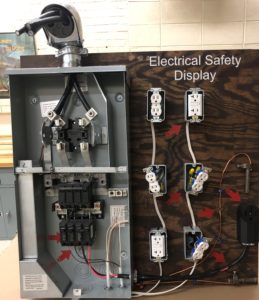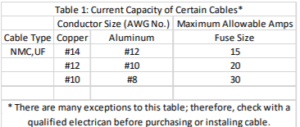Electrical Safety

Electrical Safety Display Answers
1. Breaker is too large for the circuit.
2. Exposed wire at the base of the breaker.
3. GFCI is placed at the end of the circuit, leaving it unprotected.
4. Connecting wires are exposed.
5. Outlet is broken and exposed on the opposite side.
6. Ground is broken.
7. Wires are exposed.
Electrical Safety Fact Sheet
DESCRIPTION
The objective is to provide basic information regarding electrical safety dealing with the height of overhead powerlines, wiring facilities, and the use of extension cords.
OVERHEAD LINES
Based on the National Electrical Safety Code (NESC) and the National Electric Code (NEC):
Portable Auger Systems
Overhead lines must be at least 18 feet above the tallest point on the grain bin and the loading side of the grain bin; the post must be a minimum of 38 feet from the bin.
Fixed Grain‐Handling Sytems
Overhead lines must be at least 12.5 feet above the structure’s roof and not easily accessed by people. If the roof is easily accessible, the height of the lines must be at least 18 feet above the highest point.
Roadways for Agricultural Equipment
Overhead lines must be at a minimum of 18.5 feet above the ground. Ensures the tractor or implements do not come in contact with overhead lines.
Rooflines
8‐foot clearance is needed from any roofline that is easily accessible.
WIRING AGRICULTURAL FACILITIES
Non‐metallic Sheathed Cable
“Type NMC” or “UF” cable is recommended for damp environments which can occur in agricultural facilities.
The gauge of cable is determined by the length of run and the power demand of the equipment.

Metal or PVC (plastic) conduit provides extra protection to cables from livestock, rodents, and general wear. PVC is preferred due to its resistance to corrosion and less expensive.
Electrical cables need to be in open areas for inspection, and any switches or other electrical components out of reach of livestock.
Ground‐Fault Circuit Interrupters (GFCI)
- GFCI is a circuit breaker designed to prevent shock
to people or animals in wet or damp conditions. - Any equipment plugged into a GFCI protected
receptacle will have ground‐fault protection. - Do NOT remove the GFCI prong on electrical plugs.
EXTENSION CORD USE CHECKLIST
- Do not use in wet areas.
- Do not try and repair a damaged extension cord.
Replace the cord. - Keep cords away from sharp objects, heat, oil,
and other solvents that could damage the
insulation. - Always check extension cords for damage before
use. - Do not overload the extension cord.

